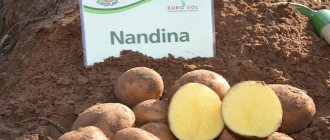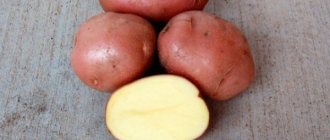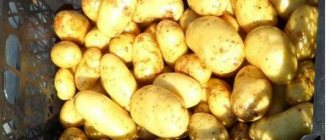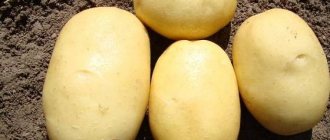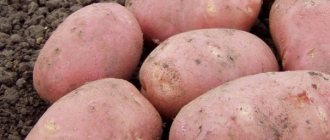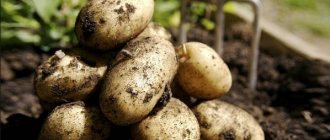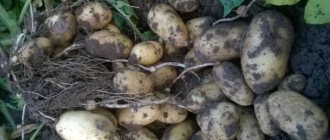Description of the potato variety Melody
Variety “Melody” is a mid-late table selection potato. Since 2009, it began to land in the Russian Federation, mainly in the central regions. This variety cannot be called universal or super-resistant, but it has a number of rare advantages that have made it valuable for gardening, and especially for industrial cultivation.
Escapes
The bushes are about half a meter in height. The leaves are medium-sized, closed, oblong, bright green, with a wavy edge. The “Melody” variety blooms with 5-7 buds. Their color is white and light lilac at the edges, darkening to purple in the center and violet-red in the middle, which is yellow.
Roots
The tubers are large, with a peel, mesh in structure, pale yellow in color, oval in shape, small, dark gray eyes. The average weight of a potato is 100-180 g; it has soft yellow flesh that boils quickly. It has a high starch content - 17-20%. Due to this, it is used for the industrial production of dry mashed potatoes.
Features of cultivation
After the first shoots appear, the Melodiya potatoes need care. It consists of timely watering, weeding, loosening and fertilizing.
Watering
At first, after sprouting, potatoes do not require watering, since the plant gets everything it needs from the tuber. Later, you need to ensure that the soil does not dry out more than 5 cm deep. If precipitation falls regularly, Melodiya potatoes do not require additional irrigation. In case of dry weather, watering is carried out twice a week, using up to 5 liters of water for each plant.
Top dressing
If the soil is poor, fertilizer is applied twice - as soon as the shoots reach a height of 20-25 cm, and before flowering. In the first case, urea is used (20 g per 10 liters of water), in the second, 60 g of ash, 60 g of superphosphate and 20 g of potassium sulfate are dissolved in 10 liters. Foliar feeding in the form of spraying can not only give the potatoes additional nutrition, but also protect them from diseases. For this purpose, manganese, boron, copper sulfate, superphosphate and potassium chloride are used.
Weeding, loosening and hilling
To fully saturate the soil with oxygen, it is necessary to loosen it every time after rain to destroy the crust from the surface. At this point, weeds are removed that interfere with the growth of potatoes, robbing them of nutrition and moisture. When night temperatures drop, hilling is carried out to help protect young shoots and stimulate the formation of additional roots.
Characteristics and features of the variety
The Melodiya potato variety has the following properties:
- long ripening period, from 115-120 days;
- large root vegetable;
- commercial appearance;
- keeping quality 95% - potatoes do not spoil for a long time, maintaining their taste;
- transportability, tubers easily survive shaking and mechanical damage;
- a long period of rest - 8 months, which means; that potatoes can be stored until June without the need to break out the sprouts.
- starchiness;
- drought-resistant;
- thermophilicity;
- undemanding to soil nutrition;
- retains characteristics in the second and third generations.
This variety is especially valued for its strong immunity . It is not subject to:
- wrinkled and striped mosaic;
- golden cyst nematode;
- black leg;
- scab;
- rhizoctonia;
- potato cancer;
- late blight of tops and tubers - this disease most often affects potatoes, especially in rainy weather. The likelihood of it infecting Melody is low, but still possible.
The main danger for Melodiya potatoes is the Colorado potato beetle, and the variety is not completely resistant to the Y-virus.
Characteristics
Like most Dutch potato varieties, Melodiya has high yields. The maximum marketable yield shown during state variety trials in the Moscow region of 636 c/ha exceeded the standard for the Symphony and Nikulinsky varieties.
The average marketable yield is 176-335 c/ha (18-35 kg/10 m²).
You can compare the yield indicators of Serpanok potatoes with other varieties in the table below:
| Variety name | Productivity |
| Melody | 176-335 c/ha |
| Beauty | 400-450 c/ha |
| Vector | 670 c/ha |
| Artemis | 220-350 c/ha |
| Yanka | up to 630 c/ha |
| Svitanok Kyiv | up to 460 c/ha |
| Santana | 160-380 c/ha |
| Nevsky | 300-500 c/ha |
| Taisiya | up to 460 c/ha |
| Colomba | 220-420 c/ha |
| Lapot | 400-500 c/ha |
The potato variety is among the top sellers due to its excellent appearance, high marketability (85-95%), keeping quality (95% and above), transportability and resistance to mechanical damage.
The ability to store well is an important quality for potatoes. In the table below you will find this characteristic for different varieties:
| Variety name | Keeping quality |
| Melody | 95% |
| Timo | 96% |
| Arosa | 95% |
| Spring | 93% |
| Vineta | 87% |
| Impala | 95% |
| Zorachka | 96% |
| Kamensky | 97% |
| Latona | 90% |
| Lyubava | 98% |
| Luck | 88-97% |
The characteristics of the tuber meet the requirements for mass sale with pre-washing and packaging. The dormant period is long - up to 8 months, which allows you to store Melodiya potatoes until June without breaking out the sprouts.
Productivity and taste
The volume of potatoes grown directly depends on care and weather conditions. On average it is 200-335 centners per hectare. With high-quality care for the vegetable, this figure doubles - to 636 centners (this was once collected in the Moscow region during testing of the variety). One bush often contains about 2-3 kg of potatoes (7-11 large tubers).
Melody is famous for its taste and is considered one of the most delicious potato varieties. It is suitable for boiling and pureeing, but is absolutely not suitable for frying in vegetable oils, therefore it is not used in the industrial production of chips.
Melodiya potatoes retain their pleasant yellow color during heat treatment.
Growing and care
During the growing season, the bushes must be watered three times: soon after germination, at the beginning and at the end of flowering. The rest of the time, watering is needed if there is no rain for a long time.
The soil is shed generously so that it is saturated with water to a depth of at least 50 cm. If the bushes are not watered enough during the flowering period, few tubers are formed.
Fertilizers are added to the moist soil and it is hilled up. Fertilize potatoes with weak solutions of chicken droppings or rotted manure (but in no case fresh), mineral complexes:
- After germination, nitrogen is required; you can add a solution of bird droppings or mineral nitrogen fertilizer.
- During flowering, fruit formation requires potassium and phosphorus, preferably in the form of a mineral composition.
- At the end of flowering, you can not feed it or water it with a weak solution of mullein with superphosphate.
Hill up young bushes 5-10 cm high and repeat after 2-3 weeks.
Advantages and disadvantages of the variety
The melody became popular in Russia (mainly in the central districts), Ukraine and Moldova. Presumably, the following positive qualities played a role in this:
- adaptability to temperate climates;
- easily tolerates long rainy periods;
- high resistance to diseases and viruses;
- feels good under bright sunlight, calmly tolerates lack of water;
- taste characteristics;
- high starch content.
The disadvantages of the variety mainly include its unsuitability for frying.
Origin
The originator and patent holder of the variety is the company C.MEIJER BV (Netherlands), which has been successfully operating on the Russian elite seed potato market for a long time. In 2009, the variety was zoned for the Central region by the State Register of the Russian Federation. Passed variety testing and registration in Ukraine and Moldova.
After obtaining a harvest from elite seeds purchased from large agricultural companies, you can then use your own seed material of 1-2-3 reproductions.
In order to avoid loss of varietal qualities and infection of tubers with viral diseases, the planting site is changed for 4-5 years and the planting stock is updated.
Features of planting and growing Melodiya potatoes
The “Melody” variety is not demanding in terms of care, but as in any other business, for success you need to follow the rules, in this case these are the planting rules and nuances regarding the care of the vegetable.
Optimal timing and location selection
Potatoes "Melody" are heat-loving. It can be planted only when the soil warms up to +8 degrees Celsius. This usually occurs in mid to late May.
The landing site should be on a hill accessible to the sun's rays. Before this, other nightshade crops, including potatoes of other varieties, should not grow on it. Favorable precursors include:
- legumes;
- winter crops;
- linen;
- medicinal and spicy herbs (annual and perennial);
- lupine.
Preparing the site for planting
In the fall, you should dig up the area chosen for potatoes and add organic fertilizer (compost or humus) to the soil. The volume of the latter must be at least 4.5 kilograms per 1 square meter. Add potassium and phosphate fertilizers.
In the spring, before planting, you need to supply the soil with ammonia fertilizers. Use 15-25 grams per 1 square meter, depending on its depletion. If there is underground water, it is worth making ditches and forming ridges for planting.
Tuber preparation
Before planting potatoes, you need to select seed material. From the tubers set aside from the previous harvest, whole ones are selected, without damage, darkening or signs of fungus.
They must be left in a dry place for 3-4 weeks; two days before planting, the potatoes must be placed in direct sunlight. Before being directly sent into the ground, sprouted tubers are treated with growth stimulants, which have an inhibitory effect on the development of late blight. This can be Ecosil or Epin extra.
It is better not to cut Melodiya potatoes into pieces for planting; whole tubers yield many times more yield. But if necessary, you need to ensure that the weight of each piece is not less than 50 g.
Planting in the ground, planting pattern and depth
Depending on the type of soil, you need to choose the type of planting of Melodiya potatoes:
- chernozem and sandy loam soil requires smooth planting;
- heavy soils require the creation of ridges so that the potatoes emerge more easily;
- loose loose soil necessitates the creation of trenches for planting vegetables.
The distance between rows when planting the Melodiya variety is 70-80 centimeters, and between holes is about 35 centimeters. The planting depth also depends on the type of soil; the heavier it is, the closer to the surface the tuber is placed (5-7 centimeters), and in light soils, accordingly, it is placed deeper (10-12 centimeters).
Planting material must be placed with the sprouts facing up, slightly pressing into the ground.
Fertilizer application
Additional feeding of Melodiya potatoes is not carried out after flowering. The ideal periods suitable for fertilizing are during the first hilling and before the opening of the buds.
The following fertilizers are suitable for this variety:
- dolomite flour;
- chalk;
- potassium supplements;
- egg solution;
- nitrogen supplements;
- vitamin complexes;
- herbal infusions.
It is not allowed to fertilize the “Melody” variety with bird and cow droppings, as well as other fresh organic soil fertilizing options.
Care
Potatoes need regular watering, especially during the growing season. It is carried out optionally depending on the condition and type of soil. In order not to damage the tops, water pours under the stem, but slowly, as there is a danger of exposing the root.
Hilling, the formation of mounds above the base of vegetable bushes, is carried out at least twice. The first time shoots appear 10-12 centimeters in height, the mound should be 5-10 centimeters. The second hilling must be carried out after 3 weeks.
Simultaneously with the creation of embankments, weeding (cultivation) must also be carried out. In the future, it is carried out, like watering, as needed, depending on the activity of the weeds.
Potato roots require oxygen for normal development and weight gain, so loosening must be regular.
Agricultural technology
In the spring, seed material is carefully checked for damage and signs of disease. Select healthy, even tubers in a fraction of at least 3-7 cm.
Important: If regular full irrigation or watering is not possible, agronomists advise using whole tubers when planting. If there is a shortage of planting material, use slices weighing at least 50 g.
Lupine
Recommended planting time in the Central region is mid-to-late May. Planting is carried out according to the 70x35 cm pattern. When potatoes are planted densely (550-700 bushes per 100 m²), the highest yield is achieved.
The depth of the holes depends on the type of soil. In loamy and clayey soils, tubers are buried by 7-8 cm, in light, sandy, sandy loam soils by 9-12 cm. Crop rotation is observed. The best green manures are considered to be lupine, flax, perennial and annual grasses, winter crops, and legumes.
Potatoes require regular loosening, weeding, watering, and hilling. Even in dry summers, do not leave weeds in the inter-rows to shade potato bushes; they use the mulching method. With a large biomass of neighboring weeds, the number of tubers in the nests can be greatly reduced.
The variety is demanding in terms of compliance with agrotechnical soil cultivation practices:
- In the fall, the site is dug up together with the addition of 3-4 cm of fertile soil and the addition of compost or humus at the rate of 4.5-5 kg/1 m². For heavy soils and a fertile layer of less than 30 cm, the fertilizing consumption is increased to 9 kg/m².
- When applying manure directly under the bushes, the possibility of damage to tubers increases. During autumn tillage, potassium and phosphorus fertilizers are applied superficially.
- Spring treatment consists of digging, adding 16-20 g/m² on fertile soils, or 25 g/m² on depleted soils of ammonium nitrate or ammonium sulfate.
Read more about what to feed potatoes, when and how to apply fertilizers, and how to do it correctly when planting.
When planting, it should be taken into account that the period of tuberization and active growth coincides with the peak of late blight disease. For prevention, seed material is treated with special preparations.
Harvesting begins after the tops have withered and a thick skin has formed on the tubers.
Agricultural techniques for growing potatoes can be different. Read all about Dutch technologies, about growing early varieties, about getting a harvest without weeding and hilling, about turning this process into a business. And also about such interesting methods as growing under straw, in bags, in barrels, in boxes.
Protection from diseases and pests
When planting in the holes, it is worth pouring wood ash. She:
- mineralizes the soil;
- promotes soil respiration;
- protects against insects.
To prevent late blight you can use:
- Syngenta;
- Arcedil;
- Ridomil;
- Oksikhom.
Or folk remedies:
- sprinkling the soil with lime;
- treatment of bushes with garlic infusion (100 grams per 10 liters);
- spraying with kefir solution (1:10);
- the use of solutions of potassium permanganate, boric acid and vitriol.
To prevent the spread of viruses, you must adhere to the following rules:
- select only healthy and strong tubers for planting;
- adhere to the rules of crop rotation;
- remove diseased bushes so that others do not become infected;
- destroy insect pests; they carry viruses on their paws.
It is important to treat potato bushes with fungicides and antifungals before they bloom. The following drugs are used for this:
- Alirin;
- Quadris;
- Gamair.
To combat the worst potato scourge - the Colorado potato beetle, you can use Prestige, Colorado, Regent, Taboo.
Landing rules
Before planting, it is necessary to prepare seed material. For this purpose, healthy, undamaged medium-sized tubers are selected. To speed up germination, vernalization can be carried out in the light.
The optimal time for planting potatoes in central Russia is the second ten days of May, when the soil is very wet. You should also focus on its temperature. Shoots appear quickly if the soil has warmed up to +8 ⁰C at a depth of 11 cm.
To plant Melodiya potatoes, choose an area well lit by the sun, protected from drafts by bushes.
Important! When groundwater is located close to the surface, potato beds are made high.
Fertile, moderately acidic soil - chernozem, loam, sandy loam soils - is best suited for growing root crops.
In the fall, deep plowing or digging of the soil is carried out in the selected area with the addition of organic matter and phosphorus-potassium fertilizers. Spring fertilizing should include nitrogen - ammonium sulfate or ammonium nitrate, which is added while loosening the soil. The holes for potatoes are arranged according to the pattern - 70 cm by 30 cm. The tubers are placed in the holes and covered. The depth of embedding depends on the composition of the soil - 7 cm is enough for clay, 10 cm is enough for sandy soil.
It is not recommended to fertilize the soil for potatoes with fresh manure.
Harvest and storage
Root crops of the “Melody” variety are dug up on the 115-120th day. By this time, usually the tops have already withered, and the potatoes are covered with a thick skin. Before harvesting, the ground part of Melody bushes needs to be cut off. This is done to prevent unhealthy microflora from getting from the leaves to the root of the plant.
10 days after this procedure, you can harvest the potatoes. It should be dug up and left in a bright, dry, ventilated place to dry. Afterwards, remove any adhering clods of earth and send them to a room intended for long-term storage of vegetables.
The Melodiya potato variety has high immune properties and easily survives different weather conditions of temperate climates. With careful care, Melody produces very large yields, and its taste is especially valued in the potato market. The vegetable survives long-term storage or transportation well, so it is often grown for commercial purposes.
0
0
Copy link
Features of care
The Melody potato variety needs to be looked after. This is the only way to get maximum yield. It is important to carry out the following agrotechnical measures in a timely manner:
- loosening;
- weeding;
- hilling;
- watering;
- application of fertilizers.
Owners of personal plots, summer residents, and farmers should pay sufficient attention to each of them.
Loosening
Before planting potatoes, it is important to loosen the soil. This procedure is necessary to saturate it with oxygen. Cultivate the soil to a depth of 12–15 cm without wrapping the top layer. It is recommended to do this in dry weather. On clay soils with high levels of moisture, spring loosening can be carried out twice. The first time the procedure is carried out according to the usual scheme. And in the second, it is recommended to dig up the soil onto the bayonet of a shovel, after which it is leveled with a rake. This allows you to remove excess moisture from it and enrich it with oxygen.
They also loosen the soil in the fall. They dig it up to the depth of a bayonet. There is no need to level the ground. This method of treatment ensures that all pathogenic bacteria located on the top layer of soil die. Thanks to this natural method of freezing, it is possible to prevent the development of diseases. Also, during the winter, the dug up soil is actively saturated with oxygen.
Weeding
During the weeding process, all weeds are removed. This procedure also allows you to fluff up the soil and create suitable conditions for Melodiya potato tubers for growth and development by saturating the top layer of soil with oxygen.
Experts recommend weeding Melody potatoes twice a season. The first weeding is carried out 3–4 weeks after planting the tubers. At this time, the potato sprouts should have already hatched and reached a height of 2–4 cm. The second time it is done when the bushes have grown to a height of at least 20 cm, but have not yet begun to bloom.
Experienced summer residents and farmers advise not to leave weeds even between the rows. With a large number of weeds, all useful substances are drawn out of the soil. As a result, the potatoes become smaller.
Important! If you plant poorly sprouted potatoes, there is a possibility that weeds will appear before the first shoots. In such a situation, it is advised to carefully remove them using a flat cutter.
Hilling
Weeding of the Melodiya variety is often combined with hilling. This procedure protects young shoots from sudden cold snaps. Observant owners of household plots say that after hilling, the growth of potatoes accelerates.
Hilling is carried out several times a season. It is necessary to repeat this procedure if the bushes begin to fall apart and nests are formed not along the ridge, but across it. Also, re-hilling is required if tubers begin to peek out from under the ground.
It is better to carry out the procedure in cool weather after rain. Wet soil will not fall off the ridge. In addition, moistened soil stimulates the creation of additional shoots on which potato tubers will grow.
Watering
The required amount of moisture is calculated individually depending on the characteristics of the soil in which the Melodiya potato variety was planted. In the rainy season, additional watering is not needed, but in the dry season the soil must be moistened. Watering is carried out a few days after the soil is completely dry.
Fertilizer application
It is necessary to plan the location for future planting of potatoes in the fall. It is dug up for the winter with the simultaneous addition of fertile soil, humus and compost are added to the site on the basis that 4.5-5 kg is required for every 1 m2. The norm is increased for heavy soils to 9 kg/m2. Surface application of phosphorus and potassium fertilizers is also recommended.
When loosening the soil in spring, ammonium sulfate and ammonium nitrate are added. On fertile soils, 16-20 g/m2 is required, and on depleted soils 25 g/m2.
Warning! Manure is not applied directly under the tubers. This can cause damage to the potatoes.
Pests and diseases
Since the Melodiya variety is resistant to most diseases, attention should be paid to the prevention and treatment of late blight. To do this, planting material is carefully selected, treated with a fungicide, crop rotation is observed, and pests that can carry the virus are destroyed.
At the first symptoms of late blight, fungicides are sprayed twice with an interval of 10 days.
The most dangerous pest for Melodiya potatoes is the Colorado potato beetle. For preventive purposes, the insecticide “Prestige” is used, treating the tubers with it at the time of planting. To combat the beetle and its larvae, both chemical preparations (Regent, Colorado) and biological ones (Bikol, Fitoverm) are used.
